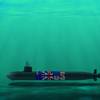Adm. Natter to Pass Command of U.S. Fleet Forces Command, Atlantic Fleet
Adm. Robert J. Natter will relinquish command of the Navy’s Fleet Forces Command and U.S. Atlantic Fleet to Adm. William J. Fallon in a ceremony to be held aboard the aircraft carrier USS Theodore Roosevelt (CVN 71) here Oct. 3. Fallon comes to Norfolk from Washington, D.C., where he most recently served as the Vice Chief of Naval Operations. As Commander, U.S. Atlantic Fleet, Natter bore the responsibility for 156 ships, nearly 1,200 aircraft, 18 major shore stations and more than 129,000 personnel during an unusually critical three-year period in naval history. Since he assumed command June 23, 2000, the Navy was called on repeatedly to deploy in defense of the nation. The attack on USS Cole (DDG 67) in October 2000 and the terrible events in New York and at the Pentagon, Sept. 11, 2001, tested the readiness of the Atlantic Fleet. The bombing and subsequent repair of Cole punctuated Natter’s leadership and determination. Despite significant damage from the attack, the ship has been returned to full service and will deploy later this year to continue the Navy’s efforts in the global war on terrorism. Additionally, in response to the attack, Natter created the Mobile Security Force, consolidating the Mobile Security, Naval Coastal Warfare and Explosive Ordnance assets into the single Maritime Force Protection Command. The Sept. 11, 2001, terrorist attacks on New York City and the Pentagon required immediate action, including from the U.S. Atlantic Fleet. In response to the crisis, Natter immediately dispatched the USS George Washington (CVN 73) and USS John F. Kennedy (CV 67) Carrier Battle Groups, to provide air defense and other support. With the creation of the Homeland Security Department, U.S. Northern Command was established to safeguard the continental United States. In October 2002, Natter became the first Commander, Naval Forces NORTH. As the naval component commander to the Department of Defense’s U.S. Northern Command, he is responsible for protecting the nation from all maritime threats to homeland security on both coasts. While the bolstered defensive posture along the country’s coasts has been a newer focus, the Atlantic Fleet was actively engaged in fighting two more traditional wars overseas. The Atlantic Fleet has gone through numerous changes since Natter took command. The most notable is the additional responsibilities given to him as the first commander of the newly established Fleet Forces Command, or CFFC, in October 2001. CFFC is responsible for the overall coordination, establishment and implementation of integrated requirements and policies for all U.S. Navy ships and squadrons during their inter-deployment training cycles. Use of the Navy’s principal training range on the island of Vieques came to end in April 2003. In its place, Natter implemented the Training Resource Strategy, or TRS. TRS allows the Navy to maintain combat superiority by better utilizing existing training ranges on the east and gulf coasts. It also utilizes the Virtual At Sea Trainer, a system that allows ships’ crews to fire at realistic simulation targets. Evaluators can then grade crew performance either from the ship or ashore. Natter enhanced training efficiencies, but more importantly, he spearheaded efforts to streamline the way the Navy will deploy its ships in the future. When the majority of the Atlantic Fleet surged to fight in Operation Iraqi Freedom, Natter agreed with the Chief of Naval Operations that the Navy needed to rethink how it deployed and maintained presence globally. Natter and his staff developed and instituted the Fleet Response Plan (FRP). FRP has revolutionized Navy planning and has been heralded as a possible training and maintenance model for adoption by all service branches. The plan calls for the Navy to have six surge-ready carrier strike groups, and an additional two carrier strike groups ready to follow shortly thereafter. This has resulted in a new way of thinking about how the Navy mans, maintains, equips, trains and ultimately, fights, its ships. Natter enlisted as a Seaman Recruit in the U.S. Naval Reserve in 1962. Forty-one years later, he has left an indelible stamp on our nation’s Navy that is now more flexible, responsive, and lethal than anytime in its history.











